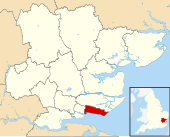Southend Pier

Southend pier in 2007
|
|
| Type | Pleasure, RNLI lifeboat station |
|---|---|
| Carries | Pedestrians, shuttle train, lifeboat crews/supplies |
| Spans | Thames Estuary |
| Locale | Essex, UK |
| Maintained by | Southend Council |
| Design | James Brunlees |
| Construction | Hardwood decking on iron piles |
| Owner | Southend Council |
| Total length | 2,158 metres (7,080 ft) |
| Opening date | 1830 (Iron pier, 1889) |
| Coordinates |
TQ884849 (shoreside) TQ897830 (pier head) |

Southend
|
|
Coordinates: 51°31′33″N 0°43′03″E / 51.525731°N 0.717461°E
Southend Pier is a major landmark in Southend-on-Sea. Extending 1.34 miles (2.16 km) into the Thames Estuary, it is the longest pleasure pier in the world. Sir John Betjeman once said that "the Pier is Southend, Southend is the Pier". The pier is a Grade II listed building.
In the early 19th century, Southend was growing as a seaside holiday resort. At the time, it was thought that spending time by the sea was good for one's health, and since it was close to the capital, many Londoners would come to Southend for this reason. However the coast at Southend consists of large mudflats, so the sea is never very deep even at full tide (between four and six metres), and recedes over a mile from the beach at low tide. Large boats were unable to stop at Southend near to the beach and no boats at all were able to stop at low tide. This meant that many potential visitors would go past Southend and on to Margate, or other resorts where docking facilities were better.
To counter this trend local dignitaries pushed for a pier to be built. This would allow boats to reach Southend at all tides. The campaign was led by former Lord Mayor of the City of London Sir William Heygate, 1st Baronet, a resident of Southend.
On 14 May 1829 the first Pier Act received the Royal Assent. On 25 July the Lord Mayor of London Sir William Thompson laid the foundation stone of the first section of the pier. By June 1830 a 600-foot (180 m) wooden pier was opened, based on oak piles. However this was still too short to be usable at low tide, so by 1833 it had been extended to three times its length and by 1848 was the longest pier in Europe at 7,000 feet (2,100 m). It was sold by the original owners for £17,000 in 1846 after getting into financial difficulties.
...
Wikipedia
